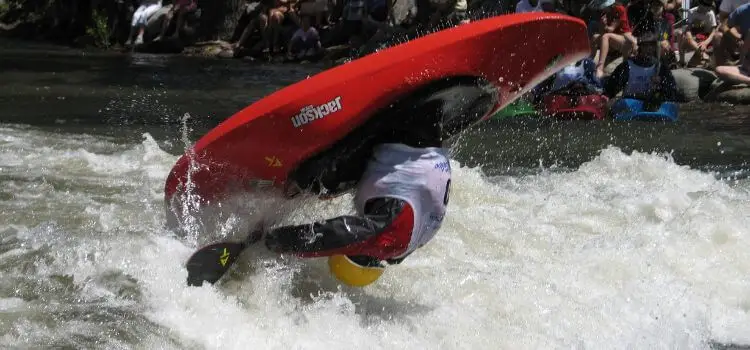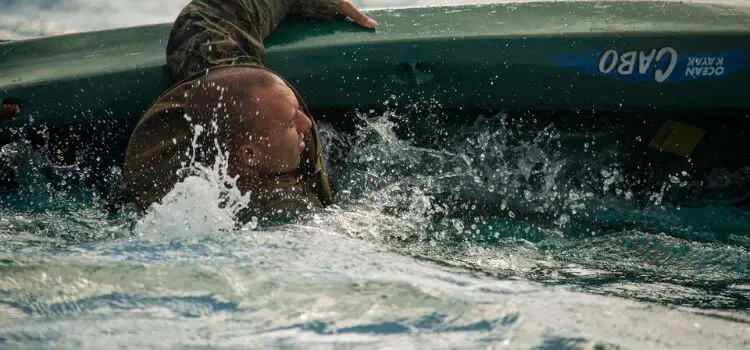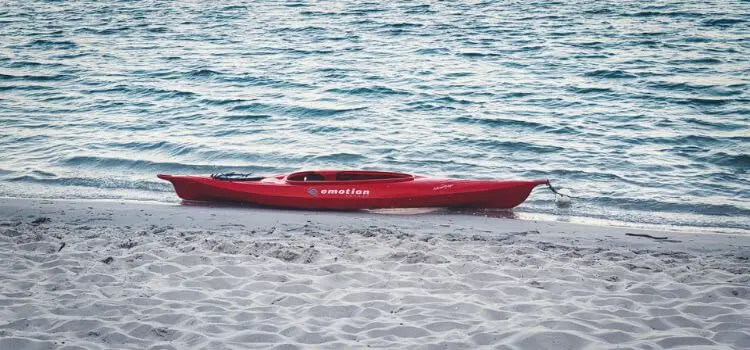As an Amazon Associates, I earn from quality purchases.
When it comes to kayaking, one common concern that often arises is the stability of kayaks and the potential for flipping. The last thing you want is to find yourself capsized in the middle of a lake or river. So, the question arises: Are kayaks easy to flip?
Whether you’re a seasoned paddler or a beginner, understanding the stability of kayaks is crucial. For, it will determine a safe and enjoyable experience on the water for you.
In this article, we will delve into the concept of kayak stability. We will explore the factors that influence it. We will also address the question of whether kayaks are truly prone to flipping.
So, let’s navigate through the waters of kayak stability and unravel the truth behind the ease or difficulty of flipping a kayak.
Factors Affecting Kayak Stability

When it comes to kayak stability, several factors come into play. Understanding these factors can help shed light on the ease or difficulty of flipping a kayak. Let’s explore the key elements that influence kayak stability:
Hull Design:
The hull design of a kayak is one of the primary factors influencing its stability in the water. Kayaks can have different types of hulls, but two common designs are flat hulls and V-shaped hulls.
Flat Hulls:
Kayaks with a flat hull design provide initial stability, making them less likely to tip over. These kayaks have a wider, flatter bottom. It creates a more stable platform for paddlers.
Flat hulls are particularly well-suited for calm waters and beginners who are still getting accustomed to the sport.
V-Shaped Hulls:
In contrast, kayaks with a V-shaped hull offer what is known as secondary stability. These kayaks have a more pointed V-shaped bottom, which helps them cut through the water more efficiently.
V-shaped hulls provide increased stability as they lean to one side. This characteristic is especially beneficial in rougher waters and for more experienced kayakers.
Kayak Width
Another critical factor in determining kayak stability is the width of the kayak. Wider kayaks generally offer better stability compared to narrower ones.
A wider kayak provides a broader base, which increases the overall stability of the vessel. This extra stability can be helpful, especially for beginners.
But, it’s important to note that wider kayaks offer enhanced stability. But, they may sacrifice speed and maneuverability to some extent. Narrower kayaks may be faster and more agile. But they can feel less stable, particularly for novice paddlers.
Kayak Flipping: Sit-in Kayaks vs. Sit-on-Top Kayaks
When it comes to kayak designs, two popular options are sit-in kayaks and sit-on-top kayaks. Let’s explore the stability of these two types and address the question of how easily they can flip.
Sit-in Kayaks
Sit-in kayaks are designed with an enclosed cockpit. The paddler sits inside the cockpit. These kayaks provide a more traditional kayaking experience. They offer better protection from the elements and a lower center of gravity.
Do sit-in kayaks flip easily?
Sit-in kayaks have a lower center of gravity. Here the paddler’s position is inside the hull. They are generally less prone to flipping. They offer good stability. They are suitable for various water conditions, including calm lakes, rivers, and even some mild coastal areas.
However, it’s important to note that the stability of a sit-in kayak can still be influenced by factors such as hull design and width.
Sit-on-Top Kayaks
Sit-on-top kayaks, as the name suggests, have an open deck where the paddler sits on top of the kayak. These kayaks provide a more relaxed and user-friendly experience for beginners.
Stability of sit-on-top kayaks:
Sit-on-top kayaks are generally considered more stable than sit-in kayaks. Their wider and flatter hull designs contribute to better initial stability, making them less likely to tip over. This makes sit-on-top kayaks an excellent choice for recreational paddling and fishing.
It’s important to note that while sit-on-top kayaks offer excellent stability, they may be more susceptible to water splashing onto the paddler due to the open deck design.
Additionally, their higher center of gravity can make them slightly less efficient in terms of speed and maneuverability compared to sit-in kayaks.
Consequences of a Kayak Flip

Whether you’re a beginner or an experienced kayaker, understanding the consequences of a kayak flip is crucial for your safety on the water. Let’s address the questions about what happens when a kayak flips over and whether it will sink.
What happens if a kayak flips over?
When a kayak flips over, the immediate consequence is that you find yourself in the water. This can be disorienting and potentially dangerous. It’s important to remain calm and focused in such situations.
Will a kayak sink if flipped?
Generally, kayaks are designed to stay afloat even when flipped over. Most modern kayaks have built-in buoyancy in the form of sealed air chambers or bulkheads. They help them remain buoyant even if filled with water.
This design feature ensures that the kayak remains afloat. Thus, making it easier for paddlers to retrieve and reenter the kayak or swim to safety.
Importance of proper safety measures and techniques:
While the likelihood of a kayak flipping can vary depending on various factors, it’s crucial to rank safety at all times. Here are some essential safety measures and techniques to keep in mind:
Wear a personal flotation device (PFD):
Wearing a properly fitted PFD is essential for your safety on the water. It provides buoyancy and helps you stay afloat in case of a kayak flip.
Develop proper paddling skills:
Learning and practicing proper paddling techniques can improve your stability and maneuverability. They will reduce the chances of a flip.
Be aware of weather and water conditions:
You have to understand the weather forecast and the conditions of the waterbody you’re kayaking in. Avoid paddling in adverse weather or rough waters that increase the risk of flipping.
Remember, prevention and preparedness are key to ensuring a safe and enjoyable kayaking experience.
Kayak vs. Canoe: Comparing Stability
When it comes to comparing the stability of kayaks and canoes, there are distinct differences to consider. Let’s address the question of whether kayaks are easier to flip than canoes and highlight the variations in stability between these two types of vessels.
Kayak vs Canoe: Which one flips easily?
The stability of kayaks and canoes depends on several factors. Design, size, and individual skill play vital role in determining the stability.
In general, kayaks tend to have better inherent stability and are less likely to flip compared to canoes. This is mainly due to the differences in their designs and how they interact with the water.
Differences in stability between kayaks and canoes:
Design:
Kayaks typically have a narrower profile with a lower center of gravity. This design allows them to cut through the water more efficiently and offers increased stability.
On the other hand, canoes have a wider and more open design. It makes them more prone to tipping, particularly in rougher waters or when weight distribution is unbalanced.
Seating position:
In a kayak, the paddler sits lower and closer to the water’s surface. It provides a more stable and connected feeling.
Canoes, on the other hand, have higher seating positions. It can lead to a higher center of gravity and reduced stability.
Weight distribution:
Canoes need careful weight distribution to maintain stability. Uneven weight distribution or sudden movements within a canoe can increase the risk of flipping.
In contrast, kayaks are more forgiving when it comes to weight distribution, making them easier to handle in terms of stability.
While kayaks generally offer better stability, canoes have their advantages as well. Canoes provide more open space. It allows easier entry and exit and the ability to carry larger loads or multiple passengers. Additionally, canoes can offer better initial stability when the water is calm.
Tips for Kayaking Without Flipping
Kayaking without flipping requires a combination of proper technique, body positioning, and balance. Here are some practical tips to help you maintain stability and enjoy a safe kayaking experience:
Get a good grip:
Maintain a firm grip on the paddle. Gripping it too tightly can cause unnecessary tension and affect your balance.
Sit with proper posture:
Sit straight with your back straight. Keep your shoulders relaxed. This posture helps maintain your center of gravity and promotes better balance.
Find your kayak’s sweet spot:
Position yourself in the kayak so that your weight is evenly distributed. Experiment with slight adjustments to find the sweet spot where the kayak feels most stable.
Engage your core:
Engaging your core muscles helps stabilize your body and maintain balance. Keep your abdominal muscles activated and avoid slouching or leaning too far in any direction.
Paddle with smooth and even strokes:
Maintain a smooth and even paddling rhythm. Avoid jerky or exaggerated movements that can disrupt your stability. Focus on a fluid motion, using your core and torso to generate power.
Learn to brace:
Bracing is a technique used to regain balance when your kayak tilts to one side. Practice leaning slightly in the opposite direction and using your paddle as a brace against the water to prevent capsizing.
Avoid sudden movements:
Sudden movements can shift your weight and destabilize the kayak. Be mindful of your actions and make deliberate and controlled movements to maintain balance.
Be aware of your surroundings:
Keep an eye on the water conditions, including currents, waves, and obstacles. Adjust your paddling technique and posture accordingly. It will help you adapt to changing conditions and maintain stability.
Take breaks and rest:
Fatigue can affect your balance and stability. Take regular breaks to rest and relax, especially during long kayaking trips. Stay hydrated and pay attention to the signals that your body might convey.
Practice self-rescue techniques:
While it’s important to strive for avoiding a flip, it’s also essential to be prepared. Familiarize yourself with self-rescue techniques, such as re-entering the kayak from the water or performing a wet exit, in case of a flip.
By implementing these tips and continuously honing your skills, you’ll enhance your ability to kayak without flipping. Thus, you can enjoy the thrill of paddling with confidence and stability.
Choosing a Safe and Beginner-Friendly Kayak

It’s essential to choose a kayak that prioritizes safety and offers stability, especially for beginners. Let’s address the question of the safest style of kayak and provide recommendations for kayaks that offer stability and safety.
What is the safest style of kayak?
The safest style of kayak largely depends on the individual paddler’s preferences and the intended use of the kayak. For beginners, recreational kayaks and sit-on-top kayaks are often considered the safest styles. They have inherent stability and user-friendly features.
Recommendations for kayaks that offer stability and safety:
Recreational Kayaks:
Recreational kayaks are designed with stability and ease of use in mind. Thus, making them an excellent choice for beginners. They typically have a wider hull and a more open cockpit, allowing for easier entry and exit. Look for models with a high initial stability rating. They are less likely to tip over and offer a stable paddling experience.
Sit-on-Top Kayaks:
Sit-on-top kayaks are a popular choice for beginners. They have exceptional stability and self-bailing features. These kayaks have an open design, with the paddler sitting on top rather than inside a cockpit.
They offer a high level of initial stability, making them harder to flip. Additionally, sit-on-top kayaks are easy to reenter from the water, providing an added safety advantage.
Inflatable Kayaks:
Inflatable kayaks have gained popularity due to their portability, durability, and stability. They are constructed with robust materials. They provide buoyancy and stability on the water.
Inflatable kayaks are particularly suitable for beginners. They offer a high level of stability and are forgiving in case of accidental impacts.
Tandem Kayaks:
Tandem kayaks, designed for two paddlers, can be a safe option for beginners. Tandem kayaks typically have a wider hull. It offers increased stability and better weight distribution.
They can provide a sense of security and are a great way to learn and gain confidence in kayaking.
Pedal-Driven Kayaks:
Pedal-driven kayaks feature a pedal system for propulsion instead of paddling. They offer excellent stability and hands-free operation. These kayaks often have a wider hull and are designed for stability and ease of use.
They allow beginners to focus on balance and maneuvering without the added complexity of coordinating paddle strokes.
Safety should always be a priority when kayaking. Along with choosing a suitable kayak, ensure you wear a properly fitted personal flotation device (PFD), familiarize yourself with basic safety techniques, and paddle within your comfort zone.
With the right kayak and a focus on safety, you can enjoy a rewarding and secure kayaking experience.
Conclusion
Throughout this article, we have addressed several key questions. We also have provided insights into the stability of kayaks.
So, are kayaks easy to flip? Kayak stability varies depending on several factors. It’s safe to say that with the right kayak choice, proper technique, and a focus on safety, flipping a kayak can be minimized and controlled.
Practice, experience, and proper safety measures are key to enjoying a secure and stable kayaking experience. Stay safe, have fun, and happy paddling!
Frequently Asked Questions (FAQ)
Q: Do kayaks sink easily?
A: Kayaks do not sink easily. Most kayaks are designed with buoyancy in mind. They are constructed to stay afloat even if they capsize or fill with water. However, it’s important to practice proper safety measures and know self-rescue techniques in case of a kayak flip.
Q: Do you need to be strong to kayak?
A: You don’t need to be exceptionally strong to kayak. The level of strength required depends on the type of kayaking activity you engage in.
Beginners can start with recreational kayaking, which requires moderate strength and endurance.
Q: Why do kayaks tip over?
A: Kayaks can tip over due to various reasons. They can tip over for improper weight distribution, sudden movements, strong currents, waves, or external factors such as collisions with objects or another watercraft.
Additionally, the design and width of the kayak, as well as the skill level of the paddler, can contribute to tipping.
Q: Are short or long kayaks better?
A: The choice between short and long kayaks depends on personal preference and the intended use of the kayak. Shorter kayaks are generally more maneuverable and easier to transport.
Longer kayaks offer better tracking, increased speed, and stability in open water or adverse conditions. They are ideal for longer trips and more advanced paddlers.
Q: Are two-person kayaks more stable?
A: Two-person kayaks, also known as tandem kayaks, can provide increased stability compared to solo kayaks. The presence of a second paddler can also contribute to better balance and stability.

Leave a Reply